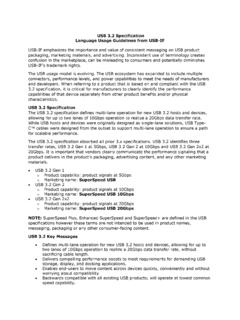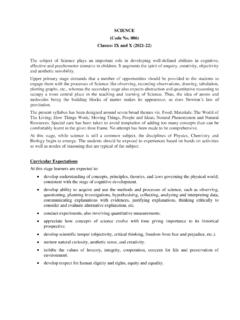Transcription of Global Forest Resources Assessment 2015
1 Global Forest Resources Assessment 2015 Desk referenceCover photo: Tom Murphy/National Geographic CreativeGLOBAL Forest Resources Assessment 2015 Desk referenceFOOD AND AGRICULTURE ORGANIZATION OF THE UNITED NATIONSRome, 2015 The Global Forest Resources AssessmentSustainably managed forests provide essential goods and services and thus play a vital part in sustainable development. Reliable and up-to-date information on the state of Forest Resources is crucial to support decision-making for investment and policymaking in forestry and sustainable , at the request of its member countries, regularly monitors the world s forests and their management and uses through the Global Forest Resources Assessment (FRA). More information on the FRA 2015 process, other publications and online database is available on the FRA web site ( ).The FRA process is coordinated by the Forestry Department at FAO headquarters in Rome in coordination with partners in the Collaborative Forest Resources Questionnaire (CFRQ).
2 These six partners are: the Central African Forest Commission (COMIFAC/OFAC), FAO, Forest EUROPE, the International Tropical Timber Organization (ITTO), the Montr al Process, and the United Nations Economic Commission for Europe (UNECE).The designations employed and the presentation of material in this informationproduct do not imply the expression of any opinion whatsoever on the part of theFood and Agriculture Organization of the United Nations (FAO) concerning the legalor development status of any country, territory, city or area or of its authorities, orconcerning the delimitation of its frontiers or boundaries. The mention of specificcompanies or products of manufacturers, whether or not these have been patented,does not imply that these have been endorsed or recommended by FAO in preferenceto others of a similar nature that are not 978-92-5-108826-5 FAO, 2015 FAO encourages the use, reproduction and dissemination of material in this informationproduct.
3 Except where otherwise indicated, material may be copied, downloaded andprinted for private study, research and teaching purposes, or for use in non-commercialproducts or services, provided that appropriate acknowledgement of FAO as the sourceand copyright holder is given and that FAO s endorsement of users views, products orservices is not implied in any requests for translation and adaptation rights, and for resale and other commercialuse rights should be made via or addressed information products are available on the FAO website ( )and can be purchased through Abbreviations and acronyms vi Introduction 1 Forest area and Forest characteristics 2 QUESTION 1: WHAT IS THE AREA OF Forest AND OTHER WOODED LAND AND HOW HAS IT CHANGED OVER TIME? Table 1. Forest and other wooded land 2015 3 Table 2. Extent of Forest 1990-2015 9 Table 3. Other wooded land 1990-2015 15 Table 4. Forest expansion 1990 2010 21 Table 5. Deforestation 1990 2010 26 Table 6.
4 Reforestation 1990 2010 29 QUESTION 2: WHAT IS THE AREA OF NATURAL AND PLANTED Forest AND HOW HAS IT CHANGED OVER TIME?Table 7. Forest characteristics 2015 34 Table 8. Primary Forest 1990-2015 40 Table 9. Other naturally regenerated Forest 1990-2015 46 Table 10. Planted Forest 1990-2015 52 Table 11. Other naturally regenerated and planted Forest 2015 58 Table 12. Mangroves 1990 2015 64 Production 70 QUESTION 3: WHAT ARE THE STOCKS AND GROWTH RATES OF THE FORESTS AND HOW HAVE THEY CHANGED? Table 13. Growing stock in Forest and other wooded land 2015 71 Table 14. Trends in Forest growing stock 1990-2015 76 Table 15. Trends in other wooded land growing stock 1990-2015 82 Table 16. Growing stock composition 2010 85 Table 17. Net annual increment in Forest 1990-2015 88 Table 18. Biomass stock in Forest and other wooded land 2015 90 Table 19. Trends in living Forest biomass 1990-2015 95 Table 20.
5 Carbon stock in Forest and other wooded land 2015 101 Table 21. Carbon stock in living Forest biomass 1990-2015 106 QUESTION 4: WHAT IS THE STATUS OF Forest PRODUCTION AND HOW HAS IT CHANGED OVER TIME?Table 22. Production Forest 1990-2015 112 Table 23. Multiple-use Forest 1990-2015 118 Table 24. Total wood removals 124 Table 25. Woodfuel removals 133 Protective functions and selective ecosystem services 142 QUESTION 5: HOW MUCH Forest AREA IS MANAGED FOR PROTECTION OF SOIL AND WATER AND ECOSYSTEM SERVICES? Table 26. Protection of soil and water 2015 143 Table 27. Ecosystem services, cultural or spiritual values 2015 147 Table 28. Protection and ecosystem services 1990 2015 150 Contents Biodiversity and conservation 154 QUESTION 6: HOW MUCH Forest AREA IS PROTECTED AND DESIGNATED FOR THE CONSERVATION OF BIODIVERSITY AND HOW HAS IT CHANGED OVER TIME? Table 29. Conservation of biodiversity 1990-2015 155 Table 30. Forest area within protected areas 1990-2015 161 Table 31.
6 Conservation and protected Forest areas 1990 2015 166 Disturbance 172 QUESTION 7: WHAT IS THE AREA OF Forest AFFECTED BY WOODY INVASIVE SPECIES? Table 32. Area affected by woody invasive species 2005-2010 173 QUESTION 8: HOW MUCH Forest AREA IS DAMAGED EACH YEAR?Table 33. Total land area burned 2003-2012 175 Table 34. Total Forest area burned 2003-2012 179 Measuring progress towards sustainable Forest management (SFM) 184 i: National-scale progress towards SFMQUESTION 10: WHAT Forest POLICY AND REGULATORY FRAMEWORK EXISTS TO SUPPORT IMPLEMENTATION OF SUSTAINABLE Forest MANAGEMENT (SFM)? Table 35. Policies supporting SFM 185 Table 36. Legislation and regulations supporting SFM 190 QUESTION 11: IS THERE A NATIONAL PLATFORM THAT PROMOTES STAKEHOLDER PARTICIPATION IN Forest POLICY DEVELOPMENT? QUESTION 12: WHAT IS THE Forest AREA INTENDED TO BE IN PERMANENT Forest LAND USE AND HOW HAS IT CHANGED?
7 QUESTION 13: HOW DOES YOUR COUNTRY MEASURE AND REPORT PROGRESS TOWARDS SFM AT THE NATIONAL LEVEL?Table 37. National platform, stakeholders, permanent Forest land use and reporting 195 ii: Operational-scale progress towards SFMQUESTION 13: HOW DOES YOUR COUNTRY MEASURE AND REPORT PROGRESS TOWARDS SFM AT THE NATIONAL LEVEL? Table 38. Methods measuring progress towards SFM 202 QUESTION 14: WHAT IS THE AREA OF Forest UNDER A Forest MANAGEMENT PLAN AND HOW IS THIS MONITORED? Table 39. Forest management plan 2010 and monitoring 212 QUESTION 15: HOW ARE STAKEHOLDERS INVOLVED IN THE MANAGEMENT DECISION-MAKING FOR PUBLICLY-OWNED FORESTS? Table 40. Stakeholder involvement at operational scale 218 QUESTION 16: WHAT IS THE AREA OF Forest UNDER AN INDEPENDENTLY VERIFIED Forest CERTIFICATION SCHEME? Table 41. Forest Stewardship Council (FSC) certification 2000-2014 223 Table 42. Programme for the Endorsement of Forest Certification (PEFC) 2000-2014 226 Table 43.
8 Domestic Forest management certification 2000-2012 227 Economics and livelihoods 228 QUESTION 17: HOW MUCH MONEY DO GOVERNMENTS COLLECT FROM AND SPEND ON FORESTS? QUESTION 20: WHAT IS THE CONTRIBUTION OF FORESTRY TO GROSS DOMESTIC PRODUCT (GDP)? Table 44. Revenues, expenditures and contribution of forestry to GDP (1 000 USD) 229 QUESTION 18: WHO OWNS AND MANAGES THE FORESTS AND HOW HAS THIS CHANGED? Table 45. Forest ownership 1990-2010 (1 000 ha) 235 QUESTION 19: HOW MANY PEOPLE ARE DIRECTLY EMPLOYED IN FORESTRY? Table 46. Employment in forestry 1990-2010 241 Acronyms and abbreviationsviCFRQ Collaborative Forest Resources QuestionnaireCOMIFAC/OFAC Central African Forest Commission/Observatoire des For ts d Afrique CentraleFAO Food and Agriculture Organization of the United NationsFLUDE Forest Land Use Data ExplorerFRA Global Forest Resources Assessment (FAO)FSC Forest Stewardship CouncilFTE full-time equivalentGDP gross domestic productITTO International Tropical Timber OrganizationPEFC Programme for Endorsement of Forest CertificationSFM sustainable Forest managementUN United NationsUNECE United Nations Economic Commission for Europem metreha hectarer a very small value that has been rounded to over barkt under barkyr year1 DESK REFERENCEThis document is one of three main publications of the Global Forest Resources Assessment 2015 (FRA 2015).
9 It contains data for most of the quantitative and Boolean variables collected through FRA 2015. For a set of summary analyses the reader is encouraged to see the publication How are the world s forests changing?.1 It provides a picture of the current state of the world s Forest Resources and of the main changes that have occurred over the last 25 years. The third publication is a special issue of the journal Forest Ecology and The peer-reviewed papers that form this special issue contain a more detailed set of analyses, based on both FRA 2015 data and other data sources. In addition to these publications, country reports containing the source data used in this document can be downloaded and analysed, together with a wide range of additional data sources and output formats, through the Forest Land Use Data Explorer (FLUDE). The Forest Land Use Data Explorer is an active analytical tool designed to provide easy access and analyses of FRA and other land use main reference documents used for the desk reference are: Country reports and desk studies:3 the reports contain detailed information on the sources of data and documentation on calculations.
10 Guide for country reporting for FRA 2015:4 the guide explains both the general reporting methodology and provides specific guidance for preparing Country Reports. Terms and Definitions document:5 the document provides definitions for all terms and categories reported in the country reports. Most definitions are complemented by explanatory more on FRA 2015, see the article by MacDicken on Global Forest Resources Assessment 2015: What, why and how? 6 or the FRA How to read and use this documentFRA 2015 provides data and analysis covering 234 countries and territories. One hundred and fifty-five reports were prepared by national correspondents nominated by government agencies responsible for forestry. The remainder comes from desk studies prepared by FAO which provide estimated values for Forest statistics in countries that did not submit a country report. While the number of desk studies is high, in total they amount to only percent of Global Forest area.












